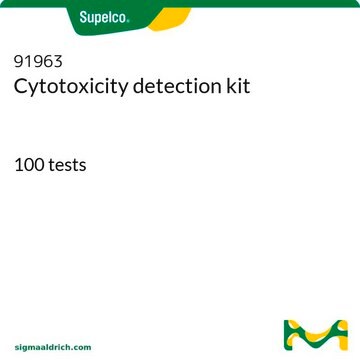96992
Cell Counting Kit - 8
for quantitation of viable cell number in proliferation and cytotoxicity assays
Select a Size
Select a Size
About This Item
Recommended Products
Quality Level
shelf life
limited shelf life, expiry date on the label
shipped in
ambient
storage temp.
2-8°C
Related Categories
Application
Cell Counting Kit-8 allows sensitive colorimetric assays for the determination of the number of viable cells in the proliferation and cytotoxicity assays. The detection sensitivity is higher than any other tetrazolium salts such as MTT, XTT or MTS.
related product
signalword
Warning
hcodes
Hazard Classifications
Carc. 2 - Eye Irrit. 2 - Muta. 2 - Skin Irrit. 2
Storage Class
12 - Non Combustible Liquids
wgk_germany
WGK 2
flash_point_f
Not applicable
flash_point_c
Not applicable
ppe
Eyeshields, Gloves
Choose from one of the most recent versions:
Already Own This Product?
Find documentation for the products that you have recently purchased in the Document Library.
Customers Also Viewed
Articles
Cell based assays for cell proliferation (BrdU, MTT, WST1), cell viability and cytotoxicity experiments for applications in cancer, neuroscience and stem cell research.
Related Content
Find protein research tools to prepare, isolate, and analyze proteins. Organized by how to extract, protect, purify, enrich, modify, and quantify proteins.
Our team of scientists has experience in all areas of research including Life Science, Material Science, Chemical Synthesis, Chromatography, Analytical and many others.
Contact Technical Service

















